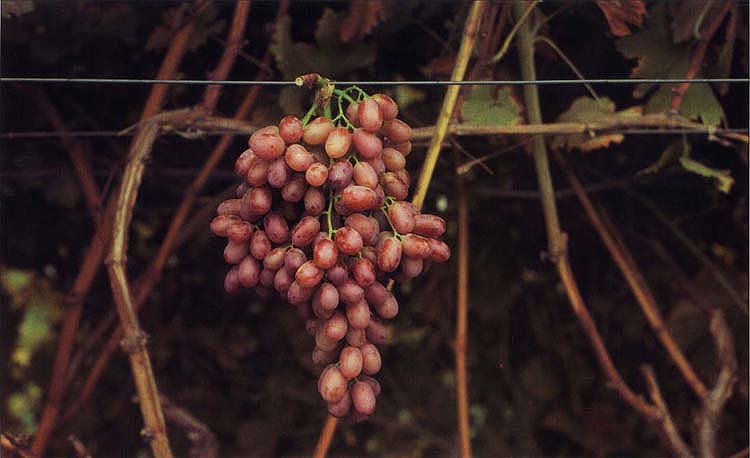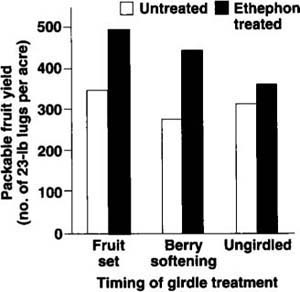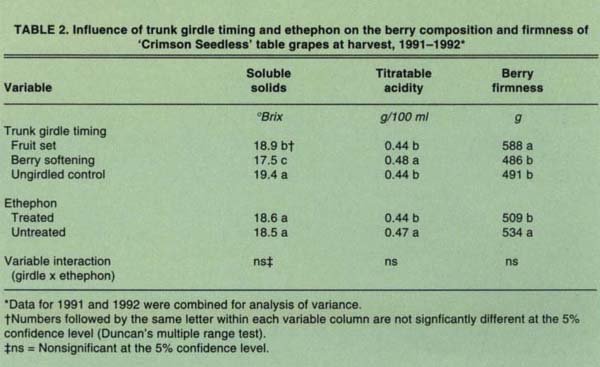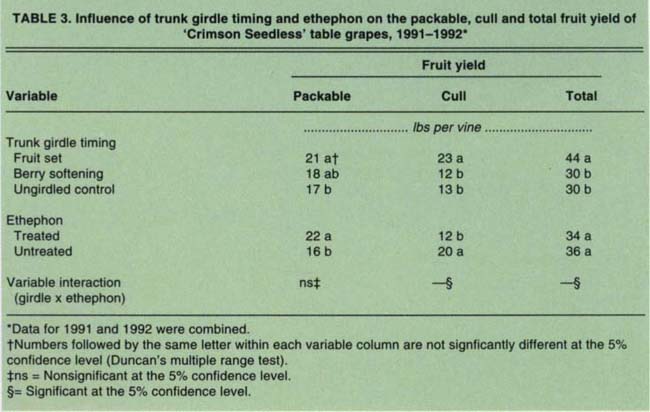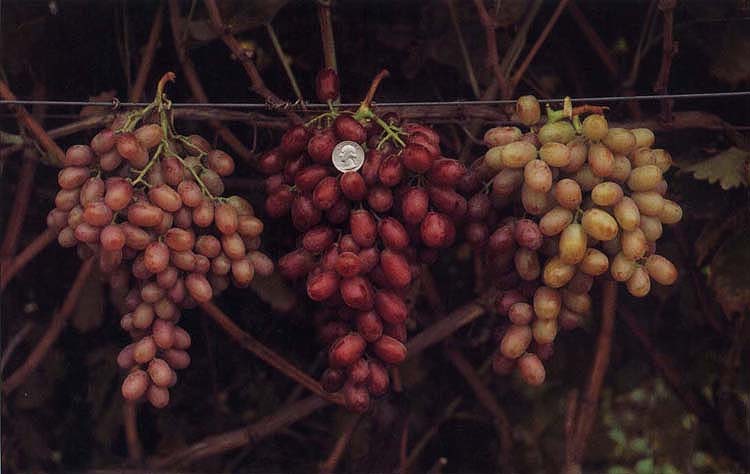All Issues
Cultural practices improve color, size of ‘Crimson Seedless’
Publication Information
California Agriculture 49(2):36-40. https://doi.org/10.3733/ca.v049n02p36
Published March 01, 1995
PDF | Citation | Permissions
Abstract
‘Crimson Seedless’ is a lateseason table grape recently developed by scientists at the USDA-Agriculture Research Service. The cultivar holds significant promise for commercial producers due to its late maturity and seedless, crisp berries. Poor color and small berry size are the primary fruit quality problems associated with the cultivar. This study shows that trunk girdles applied at fruit set, combined with applications of the plant growth regulator ethephon, significantly improve the berry size, color and packable yield of this cultivar.
Full text
Poor color and small berry size associated with ‘Crimson Seedless’, a late-season, seedless table grape variety, may be improved with cultural practices.
‘Crimson Seedless’ is a new, lateseason table grape developed by scientists at the USDA Fruit Genetics and Breeding Research Unit in Fresno, California. In 1993 there were approximately 1,000 acres of this cultivar planted in the San Joaquin Valley. ‘Crimson Seedless’ (previously known as USDA Selection C102-26) resulted from a cross of Vitis vinifera cultivar ‘Emperor’ and USDA Selection C33-199. ‘Crimson Seedless’ is the latest-ripening seedless table grape currently produced in California. The cultivar ripens in early October and, weather permitting, can be held on the vine through mid-November. When properly mature, the fruit of ‘Crimson Seedless’ is bright red and has excellent eating characteristics; its berries are firm and crisp and have good flavor. Because of its seedless, crunchy berries and late fruit maturation, many producers feel that ‘Crimson Seedless’ will be widely planted in the future. The cultivar extends the availability of seedless table grapes into the late fall, potentially expanding the late-season market for this commodity.
Obtaining adequate fruit color for harvest is a major problem. Our observations indicate that 30% or more of the fruit produced by this cultivar may remain on the vine unharvested due to inadequate color development. Another problem is the cultivar's relatively small berry size. Natural ‘Crimson Seedless’ berries are approximately 30% smaller than girdled and gibberellin-treated ‘Thompson Seedless’ table grape berries, the primary seedless table grape cultivar grown in California. Because large berries and abundant color are critical to table grape quality, it is likely that ‘Crimson Seedless’ will not achieve wide-scale commercial acceptance unless its berry size and color can be improved. The development of cultural practices to improve fruit quality is critical if this cultivar is to become a commercially important table grape.
Girdling consists of cutting out a ring of bark from the vine trunk, left. The fresh girdle, center, temporarily interrupts the flow of assimilates produced in the leaves to the roots. Vines girdled at fruit set produced larger grapes. At right is a healed girdle.
Trunk girdling and the application of the plant growth regulator ethephon are commonly employed to improve the size and color of table grapes. Trunk girdling consists of removing a ring of bark (phloem tissue) from the vine trunk to restrict the movement of assimilates from the aerial portion of the vine to the vine roots. Girdling may be performed at fruit set to increase berry size, and also at the initiation of fruit ripening or berry softening to improve fruit color and advance fruit maturation. Ethephon (trade name Ethrel) is commonly applied to red-pigmented table grape cultivars at the initiation of fruit ripening to enhance berry color. The active ingredient in ethephon, [(2-chloroethyl) phosphonic acid], produces ethylene upon its degradation. Ethylene is an endogenous plant hormone that accelerates the ripening of many fruits, including grapes.
The purpose of this study was to examine the interaction between trunk girdle timing and ethephon on the berry size, fruit color and packable yield of the ‘Crimson Seedless’ cultivar. The study revealed that trunk girdles at fruit set, combined with ethephon applications at the initiation of berry softening, significantly improved the quality and packable yield of this cultivar.
Vineyard growing conditions
The experiment was conducted in a commercial vineyard located near Delano, California. The vines were planted on their own roots in 1986 in a clay-loam soil. Row direction was east-west, and vine spacing was 8 feet (within rows) by 12 feet (between rows). The vines were trained to a bilateral cordon. A combination of spur and cane pruning was employed, with fourteen 2-bud spurs and two 15-bud canes retained on each vine in both seasons of the experiment. The trellis system consisted of 8-foot stakes and two crossarms; a 3-foot-wide crossarm was placed 4 feet above ground with two wires for tying canes, and a 4-foot-wide crossarm was placed 6 feet above ground with four foliage support wires. The vineyard was drip irrigated.
Experimental design, treatments
The 3-by-2 factorial experiment was designed in a randomized complete block, split-plot design. Main plots consisted of three trunk-girdling treatments; vines girdled at fruit set and at the initiation of berry softening were compared to ungirdled vines. Each girdling treatment was evaluated with and without the application of ethephon (split plots). Each treatment was replicated six times, using two-vine plots. The middle vine space (area between the two vine trunks) in each plot was used for data collection. The cluster number of all experimental vines was standardized to 35 following fruit set. Girdles were applied to the vine trunk using a 1/4-wide girdling knife. Fruit-set girdles were applied on June 7, 1991 and May 21, 1992, when mean berry diameter was approximately 6 mm. Berry-softening girdles were applied on July 25, 1991, and July 3, 1992, when approximately 5 to 10% of the berries were showing red color. The vine trunks were examined 1 hour after girdling to ensure that the girdles were complete. Ethephon (0.75 pints Ethrel per acre, 22% active ingredient) was applied on the same date as the berry-softening girdle. Fruit clusters and vine foliage were treated using a hand-held spray wand and 150 gallons of spray solution per acre.
Fruit compositional analyses
Fruit samples were collected and the vines harvested on November 14, 1991, and November 3, 1992. A single berry was removed from the top, middle and bottom of each cluster located in the middle vine space of each replicate (approximately 100 berries per replicate). The samples were transported to the laboratory where the berry number, berry fresh weight, berry length and berry diameter of each sample was recorded. The berries in each sample were then macerated using an electric blender, and the juice and pulp filtered and allowed to settle for approximately 30 minutes.
Aliquots of the clear juice were used to determine soluble solids content and titratable acidity. Soluble solids content (°Brix) was determined using a hand-held, temperature-compensated refractometer. Fruit acidity was determined by titrating a 5-ml aliquot of juice with 0.1 N NaOH to a pH endpoint of 8.2 using an automatic titrator. Berry firmness was measured on a 30-berry subsample of each replication using a UC fruit pressure tester. The berries (pedicils attached) were placed longitudinally on the tester platform and the amount of force required to penetrate the flesh of each berry at its equator was recorded.
Harvest
All clusters were removed from the vines at harvest, and packable and unpackable clusters were separated by a commercial packing crew and weighed. Fruit was graded cull (not marketable as table grapes) if less than 50% of the berries on a cluster were adequately colored. No other major fruit quality defects were observed in either season of the trial.
Fruit set girdles improve size
Vines girdled at fruit set produced larger berries compared to vines girdled at berry softening and ungirdled vines (table 1). Trunk girdles applied at fruit set increased berry weight 38%, berry length 12% and berry diameter 10% compared to the fruit of ungirdled vines. The berry weight and diameter of vines girdled at berry softening were significantly lower than those of ungirdled vines, while the berry length of these treatments was similar. Ethephon had no significant effect on berry weight, length or diameter. Significant variable interactions (girdle timing x ethephon) were not observed for the berry growth components presented in table 1.
The fruit soluble solids content of ungirdled vines was significantly greater than that of vines girdled at fruit set and vines girdled at berry softening (table 2). The larger berry size and greater total yield of vines girdled at fruit set was probably responsible for the lower fruit soluble solids content of this treatment. Fruit maturity was also delayed when vines were girdled at berry softening. Vines girdled at berry softening had lower soluble solids and higher titratable acidity compared to ungirdled vines. Ethephon had no effect on fruit soluble solids content; however, vines treated with ethephon had lower titratable acidity compared to untreated vines. The berry firmness of vines girdled at fruit set was significantly greater compared to vines girdled at berry softening and ungirdled vines. Ethephon significantly reduced berry firmness compared to untreated vines. No significant girdle timing x ethephon interaction was observed for the parameters of berry composition and berry firmness.
Due primarily to their larger berry size, the total yield of vines girdled at fruit set was approximately 45% greater than vines girdled at berry softening and ungirdled vines (table 3). However, due to poor fruit color development, only a portion of this increase in total yield was packable fruit. The packable yield of vines girdled at fruit set was 17% greater than that of vines girdled at berry softening, and 23% greater than that of ungirdled vines. The cull yield of vines girdled at fruit set was nearly double that of the other girdling treatments. The primary fruit quality defect among the girdling treatments in both seasons was poor color. Ethephon applications significantly improved fruit color, increasing packable yield 38% and decreasing cull yield 40%. Ethephon had no significant influence on total yield per vine. No significant variable interaction was observed for packable yield; however, significant girdle timing x ethephon interactions were found for cull yield and total yield per vine.
Fig. 1 shows the interaction between trunk girdle timing and ethephon on the packable yield of ‘Crimson Seedless’. Ethephon significantly improved fruit color, thereby increasing the amount of packable fruit in each girdling treatment. Ethephon increased the number of lugs of packable fruit per acre produced by vines girdled at fruit set by approximately 40%, from 347 to 495. Ethephon increased the packable yield of vines girdled at berry softening 60%, from 276 to 444 lugs per acre. Ethephon also increased the packable yield of ungirdled vines from 315 to 359 lugs per acre, an increase of about 14%.
Fig. 1. Influence of trunk-girdle timing and ethephon on the packable yield (lugs per acre) of ‘Crimson Seedless’ table grapes.
Ethephon improves color
Improving berry color is the principal challenge for increasing the packable fruit yield and quality of ‘Crimson Seedless’. Ethephon applied at the initial stages of fruit ripening improved both the depth and uniformity of berry color and as a result increased the packable yield of ‘Crimson Seedless’ in this study. Ethephon applications also resulted in a small decrease in berry firmness as measured by the fruit pressure tester; however, this reduction could not be detected during informal sensory evaluations performed in our laboratory. Ethephon is registered for use on this cultivar in California, and its application should become a standard cultural practice in the production of ‘Crimson Seedless’. Additional work is currently underway to determine the interaction between ethephon application timing and rate on the color development of this cultivar.
The results of this study indicate that girdling at fruit set may be a useful practice for improving the berry size and firmness of this cultivar. However, fruit-set girdles must be combined with ethephon applications if packable yields are to be improved. Growers must be cautious not to use fruit-set girdles in seasons of heavy fruit set, or in vineyards where excessive fruit set commonly occurs. Under these conditions berry-set girdles result in tight, compact clusters with a higher susceptibility to bunch rot. Girdling at berry softening did not improve the packable yield (fruit color) or fruit maturity (soluble solids) of the vines in this study. These results are in contrast to those of previous studies, which indicated that this practice improved the color and advanced the maturity of early and midseason red-and black-pigmented table grape cultivars. We cannot explain why these girdles were ineffective in this experiment; however, we plan to examine the treatment further. Based on these results, girdles applied at berry softening provide little benefit for improving the fruit quality of ‘Crimson Seedless’.
At present, trunk girdles applied at fruit set appear to be the best way to increase the berry size of this cultivar. Gibberellic acid (GA3) is commonly used to reduce the fruit set and increase the berry size of seedless table grape cultivars. However, early reports indicate that rates of GA3 similar to those used for the berry thinning and sizing of other seedless cultivars are phytotoxic to ‘Crimson Seedless’ grapevines and may result in reduced bud fruitfulness the year following application. We are currently evaluating the efficacy and long-term effects of GA3 berry thinning and sizing applications on this cultivar. We are also examining the effects of other cultural operations, such as crop load and fruit-management practices, on the quality of ‘Crimson Seedless’. The goal of this work is to develop cultural practices that optimize the quality of California table grapes purchased by consumers.
TABLE 1. Influence of trunk girdle timing and ethephon on the berry weight, length and diameter of ‘Crimson Seedless’ table grapes at harvest, 1991–1992*
TABLE 2. Influence of trunk girdle timing and ethephon on the berry composition and firmness of ‘Crimson Seedless’ table grapes at harvest, 1991–1992*
TABLE 3. Influence of trunk girdle timing and ethephon on the packable, cull and total fruit yield of ‘Crimson Seedless’ table grapes, 1991–1992*
The ‘Crimson Seedless’ table grapes on the left were grown on a vine girdled at fruit set. The vine girdled at fruit set and treated with ethephon at the initiation of berry softening produced the middle cluster, which had largest and brightest red berries. The cluster on the right was grown without girdling and ethephon treatment.



